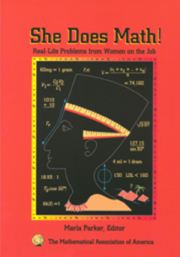Book contents
- Frontmatter
- Preface
- Contents
- Problems by Subject
- Environmental Psychology
- Software Engineering; Computer Science
- Archaeology
- Mathematics and Computer Science
- Civil Engineering
- Mathematics
- Electrical Engineering
- Physics; X-ray Astronomy Research
- Mathematics
- Physics; Astronaut Crew Training Instructor
- Business Data Processing
- Software Engineering; Real Estate Investment
- Quality Engineering
- Health Science
- Nursing Education
- Electrical Engineering; Space Systems
- Oil and Gas Accounting
- Business Administration Higher Education
- Aerospace Engineering
- Structural Engineering
- Computer Science
- Mathematics
- Dietetics—Foodservice Management and Nutrition
- Electrical Engineering
- Chemical Engineering, retired
- Software Engineering
- Immunology and Microbiology
- Mechanical Engineering
- HMO Pharmacy Practice and Management
- Ophthalmology
- Electrical Engineering
- Fish Pathology
- Computer Science and Computer Graphics
- Mathematics and Computing
- Electrical Engineering
- Astronomy
- Author
- Mathematics
- Reflections on WAM
- Solutions
Mechanical Engineering
- Frontmatter
- Preface
- Contents
- Problems by Subject
- Environmental Psychology
- Software Engineering; Computer Science
- Archaeology
- Mathematics and Computer Science
- Civil Engineering
- Mathematics
- Electrical Engineering
- Physics; X-ray Astronomy Research
- Mathematics
- Physics; Astronaut Crew Training Instructor
- Business Data Processing
- Software Engineering; Real Estate Investment
- Quality Engineering
- Health Science
- Nursing Education
- Electrical Engineering; Space Systems
- Oil and Gas Accounting
- Business Administration Higher Education
- Aerospace Engineering
- Structural Engineering
- Computer Science
- Mathematics
- Dietetics—Foodservice Management and Nutrition
- Electrical Engineering
- Chemical Engineering, retired
- Software Engineering
- Immunology and Microbiology
- Mechanical Engineering
- HMO Pharmacy Practice and Management
- Ophthalmology
- Electrical Engineering
- Fish Pathology
- Computer Science and Computer Graphics
- Mathematics and Computing
- Electrical Engineering
- Astronomy
- Author
- Mathematics
- Reflections on WAM
- Solutions
Summary
I have been interested in math for as long as I can remember, especially the challenge of solving a problem. In my junior year of high school, I won Math Student of the Year. My teachers were pushing me to choose a career as a math teacher, but I wanted to work for the National Aeronautics and Space Administration, better known as NASA. A college recruiter suggested aerospace engineering, and informed me that engineering requires plenty of math. So I enrolled in college with the intention of becoming an aerospace engineer, but when I spoke to several senior engineering students, they recommended mechanical engineering instead, because it is a broader field. Aerospace is very similar to mechanical engineering, but concentrates on space and aerodynamics classes. In mechanical engineering, there is no specific concentration, so you can take more general classes. Needless to say, I took a lot of extra math classes. In 1988, I graduated cum laude with a Bachelor of Science in Mechanical Engineering from the University of Connecticut. Then, I left for California and a job with NASA at Ames Research Center.
There, I work as a mechanical systems design engineer. My group is a support organization for the rest of Ames. That means that scientists—biologists, physiologists, psychologists, chemists, physicists, aerodynamisists, etc.—ask my group to design the mechanical apparatus needed for their research. We also analyze existing mechanical systems and improve them. These apparatus can be anything from an airplane, to enclosed chambers used to grow plants in space, to the Space Shuttle.
- Type
- Chapter
- Information
- She Does Math!Real-Life Problems from Women on the Job, pp. 116 - 117Publisher: Mathematical Association of AmericaPrint publication year: 1995

